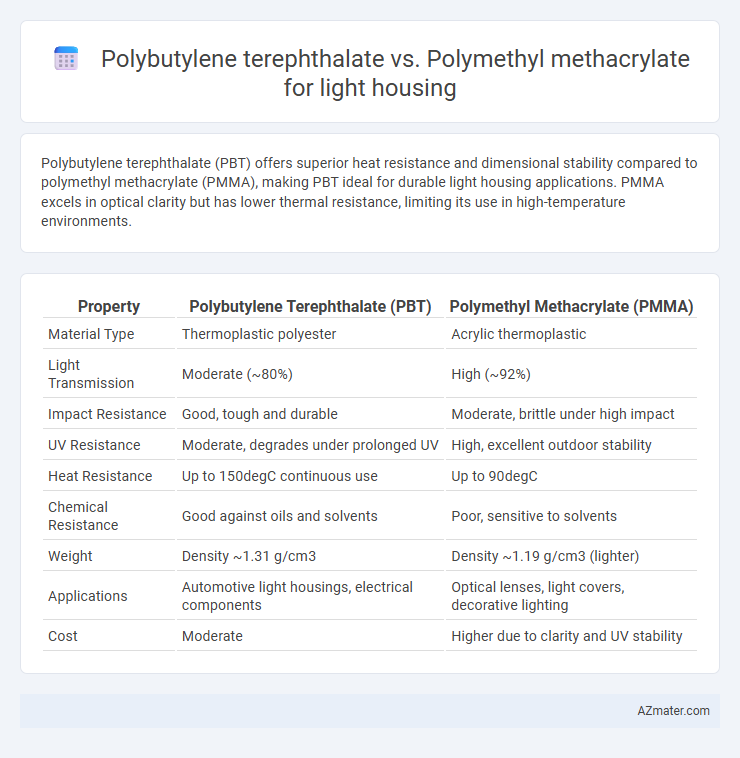Polybutylene terephthalate (PBT) offers superior heat resistance and dimensional stability compared to polymethyl methacrylate (PMMA), making PBT ideal for durable light housing applications. PMMA excels in optical clarity but has lower thermal resistance, limiting its use in high-temperature environments.
Table of Comparison
| Property | Polybutylene Terephthalate (PBT) | Polymethyl Methacrylate (PMMA) |
|---|---|---|
| Material Type | Thermoplastic polyester | Acrylic thermoplastic |
| Light Transmission | Moderate (~80%) | High (~92%) |
| Impact Resistance | Good, tough and durable | Moderate, brittle under high impact |
| UV Resistance | Moderate, degrades under prolonged UV | High, excellent outdoor stability |
| Heat Resistance | Up to 150degC continuous use | Up to 90degC |
| Chemical Resistance | Good against oils and solvents | Poor, sensitive to solvents |
| Weight | Density ~1.31 g/cm3 | Density ~1.19 g/cm3 (lighter) |
| Applications | Automotive light housings, electrical components | Optical lenses, light covers, decorative lighting |
| Cost | Moderate | Higher due to clarity and UV stability |
Introduction to Light Housing Materials
Polybutylene terephthalate (PBT) offers excellent mechanical strength, heat resistance, and electrical insulation, making it a preferred choice for durable and heat-resistant light housing applications. Polymethyl methacrylate (PMMA) provides superior optical clarity and UV resistance, ideal for transparent or translucent light covers where light diffusion and aesthetics are critical. Selecting between PBT and PMMA depends on balancing requirements for mechanical durability versus optical performance in light housing materials.
Overview of Polybutylene Terephthalate (PBT)
Polybutylene terephthalate (PBT) is a thermoplastic polyester known for its excellent electrical insulation properties, high mechanical strength, and resistance to moisture and chemicals, making it ideal for light housing applications. PBT offers superior dimensional stability and impact resistance compared to polymethyl methacrylate (PMMA), ensuring durability under thermal and mechanical stress. Its inherent flame retardancy and compatibility with UV stabilizers enhance safety and longevity in lighting fixtures.
Overview of Polymethyl Methacrylate (PMMA)
Polymethyl methacrylate (PMMA) is a transparent thermoplastic widely used for light housing due to its excellent optical clarity, high light transmittance (up to 92%), and UV resistance. PMMA's superior weatherability and impact strength make it ideal for outdoor lighting applications compared to Polybutylene terephthalate (PBT). The material's ease of molding and resistance to yellowing contribute to its popularity in manufacturing durable, aesthetically appealing light housings.
Mechanical Properties: PBT vs PMMA
Polybutylene terephthalate (PBT) offers superior mechanical strength and impact resistance compared to polymethyl methacrylate (PMMA), making it more suitable for light housings requiring durability. PBT exhibits higher tensile strength and better resistance to wear and fatigue, while PMMA provides excellent rigidity and optical clarity but is more brittle under mechanical stress. The choice between PBT and PMMA depends on the specific mechanical demands and environmental exposure of the light housing application.
Optical Performance in Light Housings
Polybutylene terephthalate (PBT) offers moderate optical clarity and excellent dimensional stability, making it suitable for light housings requiring robust mechanical strength and heat resistance. Polymethyl methacrylate (PMMA) excels in optical performance with superior light transmittance of up to 92%, high clarity, and excellent UV resistance, ideal for applications demanding maximum light diffusion and aesthetic quality. PMMA's enhanced transparency and weatherability provide optimized illumination efficiency compared to the more opaque and impact-resistant PBT.
Thermal Stability and Heat Resistance
Polybutylene terephthalate (PBT) offers superior thermal stability and heat resistance compared to polymethyl methacrylate (PMMA), making it ideal for light housings exposed to elevated temperatures. PBT maintains dimensional stability and mechanical strength at temperatures up to 150degC, whereas PMMA begins to soften around 100degC, limiting its use in high-heat environments. The inherent crystallinity of PBT also contributes to its better thermal endurance and resistance to heat-induced deformation in lighting applications.
Chemical Resistance and Durability
Polybutylene terephthalate (PBT) offers superior chemical resistance compared to polymethyl methacrylate (PMMA), particularly against oils, solvents, and alkalis, making it ideal for light housings exposed to harsh environments. PBT's enhanced durability includes excellent impact resistance and thermal stability, ensuring long-lasting performance under mechanical stress and temperature fluctuations. In contrast, PMMA, while providing excellent clarity and UV resistance, is more prone to chemical degradation and cracking, limiting its use in chemically aggressive or high-stress applications.
Processing and Manufacturing Considerations
Polybutylene terephthalate (PBT) offers superior thermal stability and dimensional accuracy during injection molding, making it ideal for complex light housing designs requiring precise tolerances. Polymethyl methacrylate (PMMA) provides excellent optical clarity but demands careful temperature control during extrusion or molding to prevent surface blemishes and internal stress. Manufacturing with PBT typically results in faster cycle times and better chemical resistance, while PMMA requires slower processing and post-processing steps like annealing to maintain transparency and structural integrity.
Cost Comparison and Market Availability
Polybutylene terephthalate (PBT) offers a cost advantage over polymethyl methacrylate (PMMA) for light housing due to its lower raw material price and ease of injection molding, resulting in reduced manufacturing expenses. PBT's widespread industrial use contributes to robust market availability, ensuring steady supply and competitive pricing compared to PMMA, which, while providing superior optical clarity, tends to be more expensive and less readily available in bulk quantities. This cost efficiency combined with broad accessibility positions PBT as a preferred choice for economical and scalable light housing production.
Conclusion: Best Choice for Light Housing Applications
Polybutylene terephthalate (PBT) offers superior thermal stability, excellent electrical insulation, and enhanced impact resistance, making it a reliable choice for durable light housing applications exposed to heat and mechanical stress. Polymethyl methacrylate (PMMA) provides exceptional optical clarity and UV resistance, ideal for transparent or decorative light housings requiring high light transmission. For most demanding light housing applications where mechanical strength and thermal endurance are critical, PBT generally represents the best choice, while PMMA suits applications prioritizing aesthetics and light diffusion.

Infographic: Polybutylene terephthalate vs Polymethyl methacrylate for Light housing
 azmater.com
azmater.com